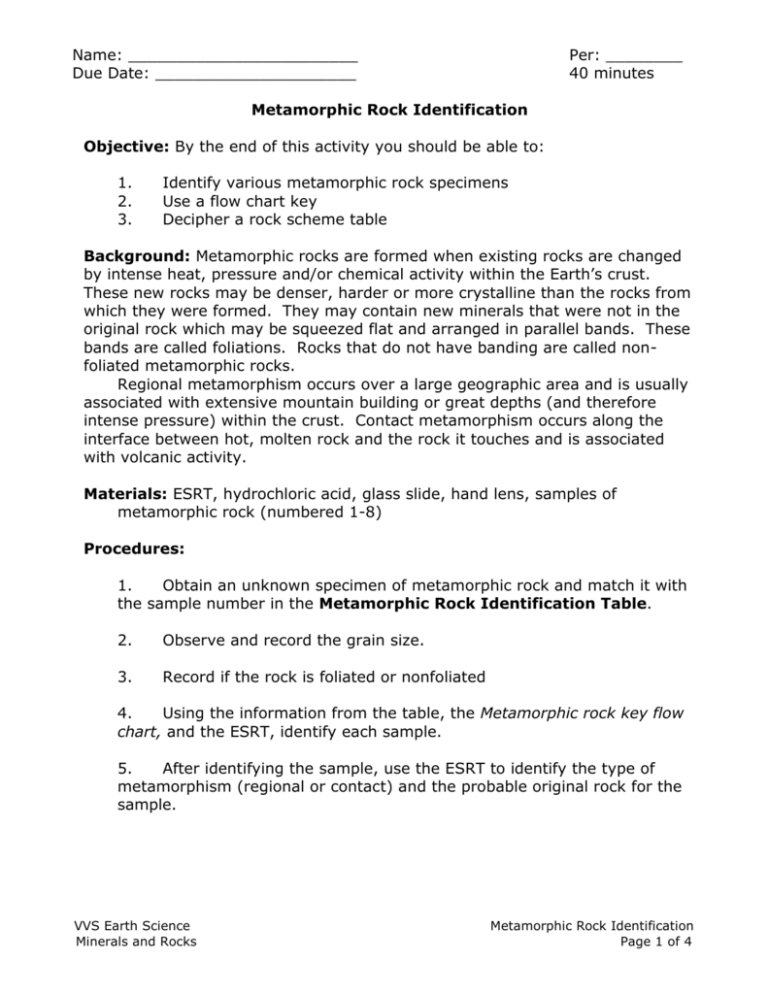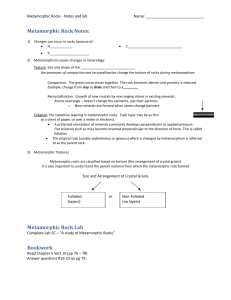Identifying Sedimentary Rocks
advertisement

Name: ________________________ Due Date: _____________________ Per: ________ 40 minutes Metamorphic Rock Identification Objective: By the end of this activity you should be able to: 1. 2. 3. Identify various metamorphic rock specimens Use a flow chart key Decipher a rock scheme table Background: Metamorphic rocks are formed when existing rocks are changed by intense heat, pressure and/or chemical activity within the Earth’s crust. These new rocks may be denser, harder or more crystalline than the rocks from which they were formed. They may contain new minerals that were not in the original rock which may be squeezed flat and arranged in parallel bands. These bands are called foliations. Rocks that do not have banding are called nonfoliated metamorphic rocks. Regional metamorphism occurs over a large geographic area and is usually associated with extensive mountain building or great depths (and therefore intense pressure) within the crust. Contact metamorphism occurs along the interface between hot, molten rock and the rock it touches and is associated with volcanic activity. Materials: ESRT, hydrochloric acid, glass slide, hand lens, samples of metamorphic rock (numbered 1-8) Procedures: 1. Obtain an unknown specimen of metamorphic rock and match it with the sample number in the Metamorphic Rock Identification Table. 2. Observe and record the grain size. 3. Record if the rock is foliated or nonfoliated 4. Using the information from the table, the Metamorphic rock key flow chart, and the ESRT, identify each sample. 5. After identifying the sample, use the ESRT to identify the type of metamorphism (regional or contact) and the probable original rock for the sample. VVS Earth Science Minerals and Rocks Metamorphic Rock Identification Page 1 of 4 Metamorphic Rock Identification Table Rock No. Grain Size Foliated or Nonfoliated Type of Metamorphism (Regional or Contact) Rock Name Origin Rock 1 2 3 4 5 6 7 8 VVS Earth Science Minerals and Rocks Metamorphic Rock Identification Page 2 of 4 Questions: 1. What characteristics do all metamorphic rocks have in common? _______________________________________________________________ _______________________________________________________________ 2. Why are fossils very seldom found in metamorphic rocks? _______________________________________________________________ _______________________________________________________________ 3. Why are the minerals in many metamorphic rocks arranged in foliations? _______________________________________________________________ _______________________________________________________________ _______________________________________________________________ 4. How can a sample of marble be distinguished from a similarly appearing sample of quartzite? ______________________________________________________________ _______________________________________________________________ _______________________________________________________________ VVS Earth Science Minerals and Rocks Metamorphic Rock Identification Page 3 of 4 VVS Earth Science Minerals and Rocks Metamorphic Rock Identification Page 4 of 4








